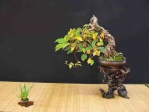Ume, Japanese Apricot
+12
John Quinn
moyogijohn
coh
Pavel Slovák
Randy_Davis
xuan le
Robert Steven
pjkatich
William N. Valavanis
drgonzo
Todd Ellis
Russell Coker
16 posters
Page 2 of 3
Page 2 of 3 •  1, 2, 3
1, 2, 3 
 Re: Ume, Japanese Apricot
Re: Ume, Japanese Apricot
Jay, some old roses have that really spicey smell. Apricots are the same, but it's different. That's the closest comparison I can think of. It's not something you forget, for sure.
As for your theory, it doesn't surprise me. This plant has been completely pot grown, except for a couple of years when it grew through the drainage holes into the ground.
As for your theory, it doesn't surprise me. This plant has been completely pot grown, except for a couple of years when it grew through the drainage holes into the ground.

Russell Coker- Member
 Re: Ume, Japanese Apricot
Re: Ume, Japanese Apricot
Smells like a cross between Tea Olive and a spicey rose. Love it!

John Quinn- Member
 Re: Ume, Japanese Apricot
Re: Ume, Japanese Apricot
Hey John, do you know about Camellia Forest Nursery near Chapel Hill? Just wondering if you've ever been. He has a nice ume list, and some too big to ship. I'd love to know what those are like...
Nice description of the fragrance too!

Russell Coker- Member
 Re: Ume, Japanese Apricot
Re: Ume, Japanese Apricot
Russell Coker wrote:
Hey John, do you know about Camellia Forest Nursery near Chapel Hill? Just wondering if you've ever been. He has a nice ume list, and some too big to ship. I'd love to know what those are like...
I found myself all over his website last night, a very nice list indeed, I wonder if they are grafted or done from cuttings? I may shoot him an e-mail about that.....
and so it begins...
-Jay

drgonzo- Member
 Re: Ume, Japanese Apricot
Re: Ume, Japanese Apricot
Jay, cool stuff for sure - but I'm not sure for your climate...
Oh, he says they're cutting grown.

Russell Coker- Member
 Re: Ume, Japanese Apricot
Re: Ume, Japanese Apricot
So is the difficulty with growing them in the cold north that they flower in say February while they are in cold storage? Can I bring them indoors at that point and let them go through their flowering cycle inside then nurse them along inside until spring?
I can grow them out in large pots and winter them over with my other trees thats not an issue
-Jay
I can grow them out in large pots and winter them over with my other trees thats not an issue
-Jay

drgonzo- Member
 Re: Ume, Japanese Apricot
Re: Ume, Japanese Apricot
I have one flowering now. I live in West Des Moines, IA. Since my winter storage is unusual and won't apply to very many people, here are some general things I've learned. You can bring them in, but it needs to be an unheated space, with light, that doesn't go below 35 degrees F., hovering around 40 degrees most of the winter. I bring my prunus mume contorta in about Halloween, when the temperature in my winter storage is about the same as it is outside. My tree needs lots of water and to bloom, lots of food. I've been working with my mume this way for seven years.
fredtruck- Member
 Re: Ume, Japanese Apricot
Re: Ume, Japanese Apricot
That's a cool tree Fred! Thanks for sharing. Obviously, I can't help out with the winter storage/minimum temp problems - THANK GOD!!!
I've not seen 'contorta' before, please tell us its history. And I'm guessing - about 18 inches??
Thanks!
R

Russell Coker- Member
 Re: Ume, Japanese Apricot
Re: Ume, Japanese Apricot
Thanks, Russell. I appreciate the compliment.
My tree is about 24" tall. I got it in 2005 from Forest Farm as regular nursery stock (as a Valentine's Day present from my wife). It is grafted. I have a very large file (140 megabytes) that is available for download that gives the history of this tree in detail, with pictures. You can download it here:
http://dl.dropbox.com/u/24827596/The%20Development%20of%20a%20Prunus%20Mume%20Contorta.pdf
But, in brief, the development of this tree actually became my development in bonsai. When I first got it, the tree was about four feet tall. I cut it back, but my mume acquired its bunjin styling very gradually. I recognized what I could do with the tree and what I couldn't. After that, the issues centered on watering the right amount, and feeding to get flowers. Maybe because the pot I used for my mume is very small, I found I had to water and especially feed a lot more than most guides suggest.
My tree is about 24" tall. I got it in 2005 from Forest Farm as regular nursery stock (as a Valentine's Day present from my wife). It is grafted. I have a very large file (140 megabytes) that is available for download that gives the history of this tree in detail, with pictures. You can download it here:
http://dl.dropbox.com/u/24827596/The%20Development%20of%20a%20Prunus%20Mume%20Contorta.pdf
But, in brief, the development of this tree actually became my development in bonsai. When I first got it, the tree was about four feet tall. I cut it back, but my mume acquired its bunjin styling very gradually. I recognized what I could do with the tree and what I couldn't. After that, the issues centered on watering the right amount, and feeding to get flowers. Maybe because the pot I used for my mume is very small, I found I had to water and especially feed a lot more than most guides suggest.
fredtruck- Member
 Re: Ume, Japanese Apricot
Re: Ume, Japanese Apricot
Really nice Fred! And thanks for mentioning Forest Farm. They have tons of great stuff, and list 11 ume varieties including 'contorta'

Russell Coker- Member
 Re: Ume, Japanese Apricot
Re: Ume, Japanese Apricot
Thanks, again, Russell. I have to say that your flowering apricot has great potential. It will be interesting to see how it develops over time.
fredtruck- Member
 Re: Ume, Japanese Apricot
Re: Ume, Japanese Apricot
Sorry to bring back an old thread but I felt this was the correct place to ask a few questions. First off that's an amazing collection of bonsai's you have.
I want to collect or purchase a flowering apricot and I live in Staten Island New York and it gets cold here.
My questions are what would be the best time to remove one from the ground or purchase one? ( help finding one for sale would be great cant find one anywhere in New York )
Once collected and of course put into a bonsai pot the correct way and start training it do I have to bring it inside for the winter or do I leave it outside all year? I would like to leave it outside all year and only bring it in the house when it is in blossom for a week or so then return it outside.
Sorry for such neiwbe questions as I just don't want to kill a tree, I do live in a house with a back yard that I have a really nice spot picked out for it once I can get my hands on one. I have kept bonsai before but years ago and never a flowering apricot so this will be my first one....also I have picked up a copy of Peter d. Adams book the art of flowering bonsai to really try an understand how theses trees thrive.
Thank you again for all your assistance.
I want to collect or purchase a flowering apricot and I live in Staten Island New York and it gets cold here.
My questions are what would be the best time to remove one from the ground or purchase one? ( help finding one for sale would be great cant find one anywhere in New York )
Once collected and of course put into a bonsai pot the correct way and start training it do I have to bring it inside for the winter or do I leave it outside all year? I would like to leave it outside all year and only bring it in the house when it is in blossom for a week or so then return it outside.
Sorry for such neiwbe questions as I just don't want to kill a tree, I do live in a house with a back yard that I have a really nice spot picked out for it once I can get my hands on one. I have kept bonsai before but years ago and never a flowering apricot so this will be my first one....also I have picked up a copy of Peter d. Adams book the art of flowering bonsai to really try an understand how theses trees thrive.
Thank you again for all your assistance.
Michaeliezza- Member
 Re: Ume, Japanese Apricot
Re: Ume, Japanese Apricot
My guess is that you'll have a hard time finding them for sale in your area, though you might be able to have a local nursery order one for you. Otherwise, you'll probably have to find a mail order supplier. Forest Farm has them as does Camellia Forest Nursery. You can also get plants from bonsai suppliers (Bill V at International Bonsai had them last year, I don't know about this year...his catalog isn't out yet).Michaeliezza wrote:
I want to collect or purchase a flowering apricot and I live in Staten Island New York and it gets cold here.
My questions are what would be the best time to remove one from the ground or purchase one? ( help finding one for sale would be great cant find one anywhere in New York )
I don't know what amount of winter protection they would need in your area...someone else would have to address that. I only have one plant that I put in the ground this spring. It grew vigorously this summer, but this will be its first winter outside...we'll see how it fares.Michaeliezza wrote:
Once collected and of course put into a bonsai pot the correct way and start training it do I have to bring it inside for the winter or do I leave it outside all year? I would like to leave it outside all year and only bring it in the house when it is in blossom for a week or so then return it outside.

coh- Member
 Re: Ume, Japanese Apricot
Re: Ume, Japanese Apricot
I think ume is safe at zone 6 for winter. I have one and I live in zone 5, but I keep it in a greenhouse-like environment during the winter. They're great trees, but demanding.
fredtruck- Member
 Re: Ume, Japanese Apricot
Re: Ume, Japanese Apricot
Thanks Michaeliezza.
I don't think I'm going to be the one who can answer your questions since I'm at the other end of the ume problem. I'd take the advice of the others guys here from the great white north if I wre you. My problems revolve around finding varieties that actually do well in a low chill "winter", and keeping them hopped up on systemic insecticides to keep away the borers.
As for this tree, it is rocking along just fine. Even with this variety the colder the winter the better the flowering. Makes it happy, but not me!
R

Russell Coker- Member
 Re: Ume, Japanese Apricot
Re: Ume, Japanese Apricot
Well thanks everyone for all your help. I will keep trying and I am sure I will find one soon. What could I expect to pay for such a tree? I know that's a touchy question but I have seen pictures on the net like the one attached for 3,000 yen about $40 us is that correct?[img][/img]
Michaeliezza- Member
 Re: Ume, Japanese Apricot
Re: Ume, Japanese Apricot
I don't see an image in the last post by Michaeliezza, so I have no idea what kind of tree he has in mind. Camellia Forest lists 3 varieties each for $30, but doesn't indicate pot or plant size. I've never purchased from them, but did call earlier this year to discuss camellias and they were very helpful on the phone. Forest Farm lists about 10 varieties in sizes from "tubes" (very small) to 5 gal. Prices range from $8 to $60. I got mine from them...it's a seedling, not one of the named varieties. I ordered the 1 gallon size ($12) and the plant I received was 30" tall and 1/4 inch trunk...basically a 2 year old seedling, I believe. I got it in late 2010, kept it in a pot for the first year, then put it in the ground this spring. It's now about 6' tall...haven't measured the trunk lately but appears to be between 3/4 and 1".

coh- Member
 flowers beds on ume
flowers beds on ume
Hello, the big problem with japanese apricots ume is tha the tree produce a lot off flowers beds and a little off limlbs beds.
KIMURA SENSEI explain that , in pot, you have to graft branches with limlbs beds if you want that tree don't die.
In france, tha year , all prunus ume without freezing protection died with temperatures : 5°F for 15 days in february.
KIMURA SENSEI explain that , in pot, you have to graft branches with limlbs beds if you want that tree don't die.
In france, tha year , all prunus ume without freezing protection died with temperatures : 5°F for 15 days in february.

abcd- Member
 Re: Ume, Japanese Apricot
Re: Ume, Japanese Apricot
Sorry, my english is very bad :
the big problem with mume is that the tree produces many flower buds and little leaves buds ( not beds ) .
KIMURA SENSEI explain that , in pot, you have to graft branches with limlbs buds if you don't graft branches with leaves buds, the tree don't grow correctly.
the big problem with mume is that the tree produces many flower buds and little leaves buds ( not beds ) .
KIMURA SENSEI explain that , in pot, you have to graft branches with limlbs buds if you don't graft branches with leaves buds, the tree don't grow correctly.

abcd- Member
 Re: Ume, Japanese Apricot
Re: Ume, Japanese Apricot
Thanks for the explanation, and no problem. There are times when I hardly understand what I'm saying myself.
fredtruck- Member
 Re: Ume, Japanese Apricot
Re: Ume, Japanese Apricot
Prunus species in the United States are available as cutting-grown material from a few sources - Camellia Forest is one on the East Coast. Evergreen Gardenworks on the West Coast. They both have many varieties and ship all over. The material is usually 1/4" to 1/2" in diameter. It is very common to see grafted Prunus sp. and sometimes you can find one where the graft is not bad - but I usually avoid the grafted material. My understanding is that in Japan they will graft a specific species - with a certain colored flower onto another prunus mume - in order to get that colored flower. Prunus species grow very fast and will have many leaves - by the late fall and early winter - the leaf buds for next year will differentiate from the flower bud - very easy to see. If the tree does not get flower buds - well then something has happened, ie. too young, too much pruning, heat stress, leaves dropped etc. There are many factors involved.......Tom
tom tynan- Member
Page 2 of 3 •  1, 2, 3
1, 2, 3 
 Similar topics
Similar topics» Apricot Oleander
» Contorted Japanese Flowering Apricot
» Fungicide soak for Japanese flowering apricot? (Or for any prunus?)
» Progression of a 'Matsubara Red' flowering apricot
» Flowering apricot photos from last March - (It won't be long now!)
» Contorted Japanese Flowering Apricot
» Fungicide soak for Japanese flowering apricot? (Or for any prunus?)
» Progression of a 'Matsubara Red' flowering apricot
» Flowering apricot photos from last March - (It won't be long now!)
Page 2 of 3
Permissions in this forum:
You cannot reply to topics in this forum







